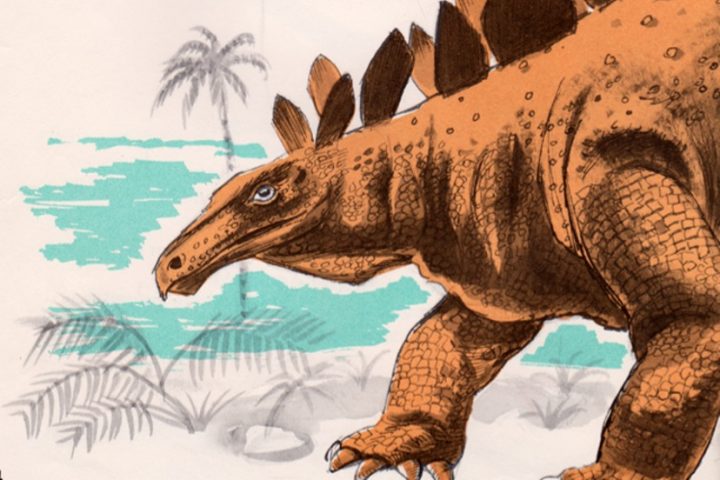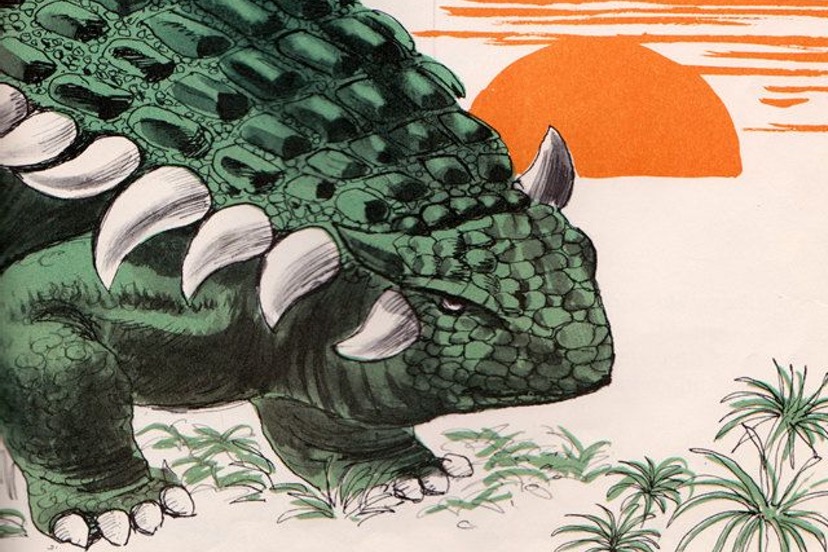My young nephew, Jason, loves dinosaurs, but has occasionally expressed his thankfulness that Tyrannosaurus Rex became extinct before he was born. Dealing with the neighbor’s surly dog is frightening enough, but meeting up with a twenty-foot carnivore with six-inch teeth, on the way to the school bus stop, would be distinctly unpleasant. Or so Jason has suggested.
Some things can be loved and appreciated more fully from a safe temporal distance of, say, 100 million years.
Anyway, I came across a book at the thrift store yesterday, and snapped it right up. A Dozen Dinosaurs; by Richard Armour; illustrations by Paul Galdone; McGraw-Hill, 1967. In good condition.
I didn’t bother to read the book prior to purchasing it, just flipped quickly through the pages and noted that several of Jason’s favorites had been included, and a nice mix of herbivores and carnivores — hinting at the primordial balance of nature, so to speak. Kids should, in my opinion, learn something about ecology and nature’s biological equilibrium, before they grow up and forget all about it.
When I stopped by Jason’s house to drop the book off, he invited me to stay and read it to him — which I hadn’t actually figured into the bargain, but given that Mr. Armour had used some unfamiliar and perhaps challenging words like “Mesozoic” and “Wyoming”, it seemed the right thing to do.
Turns out, the author had written his book in rhyming verse, with a decidedly humorous, and often satirical, tone. He wrote, for example:
Some dinosaurs were lizardlike,
Still others crocodilian,
With names like Protoceratops
Instead of Frank or Lillian.
I suppose dinosaurs made an easy target for deprecating humor when Mr. Armour was writing this book back in 1967. The stegosaurus, for instance, wasn’t around to protest when the author described his brain (I mean, the stegosaurus’ brain) as “walnut size.” If he (that is, Mr. Armour) had wanted to be more precise, the stegosaurus’ brain was more like the size of a good-size lime. But when you’re slandering someone who’s been extinct for 100 million years, I suppose you can take those kinds of liberties, with impunity.

Things have changed since 1967, however, and it’s now frowned upon — in certain social circles — to make fun of someone with a small brain, or who weighs more than an elephant (literally). Readers may notice that I’m exercising some caution, as I write this article, not to insult anyone’s tiny, useless arms or fat legs.
Author Richard Armour wasn’t bound by such socially-imposed limitations, however, and he felt free to conclude his book with this analysis:
What made the dinosaurs die out
Despite their strength and size?
Some blame it on their little brains
And lack of enterprise.
For instance, when the climate cooled
And chilled them to their throats,
They never thought of underwear
Or gloves or overcoats.
And when it turned from moist to dry
And swamps began to fail,
They brought no water in by pipe
Or aqueduct or pail.
Give thought, then, to the dinosaurs,
Whom one no longer dreads.
They used their teeth and used their claws
But didn’t use their heads.
An interesting moral, from the 1960s, a period of rather remarkable technological progress, especially here in America. (I’m guessing that Mr. Armour was American, even though he used the British spelling of his name, because he credits some California paleontologists with providing information for the book.) The US was building infrastructure like it was going out of style — highways, water treatment plants, airports, docks, power lines, dams, bridges — and we were laughing at the primitive living conditions in which the dinosaurs lived.
If anyone was “using their heads” in 1967, the Americans were a shining example.
But as Jason pointed out when we’d finished reading the book, the dinosaurs ruled the earth from the Late Triassic, and through the entire Jurassic and Cretaceous. That’s, like, 200 million years.
Humankind has been manufacturing underwear and overcoats, and building aqueducts, for maybe 5,000 years — and now we’re wondering if we’re going to make it to the end of the current century.
Maybe big brains ain’t all they’re cracked up to be.
Underrated writer Louis Cannon grew up in the vast American West, although his ex-wife, given the slightest opportunity, will deny that he ever grew up at all. You can read more stories on his Substack account.

